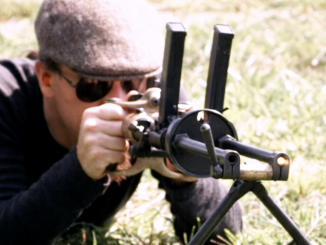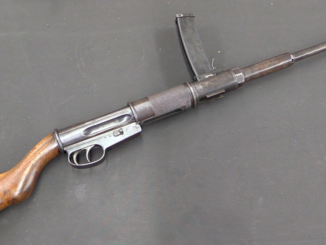The Helwan is a licensed copy of the Beretta 1951, made in Egypt. It is a single-stack, single-action 9mm pistol using the same basic locking system as the German P38. This design would later be renovated with a double-stack magazine and a double-action trigger mechanism to become the Beretta 92 eventually adopted by the US military.
Related Articles

Light MGs
WW1 Villar Perosa SMG at the Range
This is lot 1042 in the Morphy Extraordinary Auction on October 22, 2019. Courtesy of the Morphy Auction Company, I am out at the range today with a very rare Italian Villar Perosa machine gun from […]

Semiauto Rifles
Egyptian Rifle Overview
After World War II, Egypt experimented with several types of new rifle as a series of leaders bought arms from both Western and Communist nations. They included FN49 rifles from Belgium and vz52 and vz52/57 […]

Slow motion
OVP 1918: Italy’s first WW1 Submachine Gun
The original Villar Perosa machine gun was a rather odd combination of features; a double-barreled gun in 9mm Glisenti with spade grips and a blistering rate of fire. This proved to be of limited practical […]

I always thought those were cool guns but I have read that the Egyptian made pistols were iffy quality.
I guess that’d depend which Egyptian made weapons you get. Ian has done videos on other Egyptian weapons, their army rifles for example. This is a licensed design, so all the engineering work was done by Beretta. Whereas the experimental locally designed rifles seemed a little iffy in places, all their licensed designed stuff appeared (on the videos at least) to be competently put together. People have had bad Berettas, and bad Colts, and bad S&W weapons, everyone lets some lemons through now and again. Also, not everyone treats their weapons well, and that is a risk you take buying a used firearm.
We are in agreement. I’m wondering how other events influence the manufacture and design.
What I read – read on the internet no less, so all standard warnings apply – is that the steel quality was iffy and inconsistent. I doubt anyone has actually done a thorough testing and sampling. I consider any defects as a reflection of cost and material availability. The Eqyptians are using a solid design, and might have great local manufacturing and engineers, but are limited with tight budgets. The politics of the 1960s and 70s may have made it tough to import quality steel.
Egyptian military weapons, whether the Helwan pistol, the Maadi AKM, or the Port Said SMG, were perfectly functional but tended to be crudely finished, both in terms of surface finish and coatings. For instance, the paint-over-park on Egyptian AKs is really horrible, but they work just fine; the Port Said copy of the Swedish M45B is simply parked over a rough surface finish, unlike the Swedish original’s green paint over park. But they work. Make the argument that some military weapons are over finished. Chinese military AKs, for example, have a lovely rust blue. So do Romanian ones, although the Romanian rifles are often dysfunctional.
My understanding is that the military guns sold as surplus were decently good, and it was the run made specifically for commercial sale in the US were poor.
Hey Ian,
Not to be a kvetch, but if you are going to take the time to make a nice slo-mo video like this, why not take another few minutes to break down the weapon and show everybody the locking block or the super-easy takedown of this interesting pistol with an equally interesting history?
On a similar subject, I own one of these and it isn’t one of my favorite shooters as the trigger pull is hard and the locking block broke; a new one cost me sixty (!) bucks!! At that price, it will be a “gunsafe queen” for the time-being!
Steve in Prescott Valley
I plan to to a full video on the pistol later; the idea is to make a series of strictly slow-motion short videos for people who are interested in that.
If you’re familiar with the M92/M9, this M1951 is exactly the same, takedown-wise.
Thank you, Kevin. I’m intimately familiar with this pistol but some of the viewers might not be.
The main problem with some of the Helwans was quality control during manufacturing. Specifically on some, the cut-outs for the locking lugs were not heat treated to sufficient hardness and would deform with use. Some of them also have a poorly machined pointy recessed set screw that keeps the locking wedge from moving sideways that will easily come loose and mangle itself and the threads it screws in to on the bottom lug of the barrel.
I was told and shown by a gunsmith friend several Helwans he was working on. According to him, it wasn’t necessarily just the poor heat treating process that cause bad Helwans to fail. Many of them have poorly fitted locking blocks, where only a single side bear most of the load.
Cool video. I like the way you’ve stopped the action now and then to give a play by play commentary.
The design of the pistol is excellent. The gun is comfortable to hold and points well. The crossbolt safety is a bit odd until you get used to it. It works just fine if you are right handed; you can bump in the button over to the “fire” position with your thumb knuckle. Quite nifty, all in all.
Model 51 is the continiuation effort of “Open Top Barrel” concept of Beretta which gained within 35 years from the date of his first autoloading pistol, Model 1915. Though more expensive to make than common “Browning Tilting Barrel”, Beretta seemed sensing some sacrifice for sake of the keeping that well known image. The pistol used a cleverly rearranged P38 lock mechanism and its field stripping also followed the same way with P38’s. The Take Down Lever was mounted at the right side to prevent latches crowding but taken to left by ergonomical considerations at improved later models which eventually became US Service handgun,
The Helwan has a pretty poor reputation for bulging slides and broken locks. These problems are limited to the later guns made for the commercial market. You want a pistol that’s in nice shape with matching serial numbers, and the legend HELWAN CAL. 9 M/M A.R.E. on the left side of the slide. These are original Egyptian service pistols, and they’re well made. They have Arabic markings on the right side of the slide, with Arabic serial numbers, or western numbers for later guns. With the gun field stripped, the slide will ring like a bell when tapped, because it’s forged. These are really nice little pistols.
Carried on of these when I worked in Afghanistan, so I’ve got a soft spot for them.
After a 40 year hiatus, there are now newly manufactured locking blocks that are made from high strength steel, These are now available on ebay and gunbroker, so the weak link of the commercial helwan’s is no longer an issue.